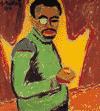- Schmidt-Rottluff, Karl
-
orig. Karl Schmidtborn Dec. 1, 1884, Rottluff, Ger.died Aug. 9, 1976, West Berlin, W.Ger.German painter and printmaker.As an architecture student in Dresden, he helped form Die Brücke in 1905. He soon realized the expressive potential of flat, patterned design; his mature style, seen in Self-Portrait with Monocle (1910), is characterized by boldly dissonant colours and jagged forms. After 1911, when he moved to Berlin, his paintings and woodcuts showed an interest in Cubism and African sculpture. Though his works had become more conventional by the 1930s, the Nazis officially declared them "degenerate." After World War II he taught art and resumed painting, but his work never regained its former power.
 Self-Portrait with Monocle, oil on canvas by Karl Schmidt-Rottluff, ...Courtesy of the Nationalgalerie, Staatliche Museen Preussischer Kulturbesitz, Berlin
Self-Portrait with Monocle, oil on canvas by Karl Schmidt-Rottluff, ...Courtesy of the Nationalgalerie, Staatliche Museen Preussischer Kulturbesitz, Berlin* * *
▪ German artistoriginal name Karl Schmidtborn December 1, 1884, Rottluff, near Chemnitz, Germanydied August 9, 1976, West Berlin [now Berlin]German painter and printmaker who was noted for his Expressionist (Expressionism) landscapes and nudes.In 1905 Schmidt-Rottluff began to study architecture in Dresden, Germany, where he and his friend Erich Heckel (Heckel, Erich) met Ernst Ludwig Kirchner (Kirchner, Ernst Ludwig) and Fritz Bleyl, two other architecture students who shared their passion for painting. Together they formed the organization of Expressionist artists known as Die Brücke (Brücke, Die) (“The Bridge”), united by the goal of creating a modern, intensely emotional style.The artists of Die Brücke typically preferred to portray scenes of urban life, but Schmidt-Rottluff is particularly known for his rural landscapes. He initially painted in an Impressionist (Impressionism) style, but his painting Windy Day (1907) shows the artist's transition to his mature style, which is characterized by flat areas of boldly dissonant colours. A representative example of this mature work is Self-Portrait with Monocle (1910). Like the other Brücke artists, Schmidt-Rottluff had also begun to explore the expressive potential of the woodcut medium. In 1911 Schmidt-Rottluff, with his fellow Die Brücke members, moved to Berlin, where he painted works with more angular, geometric forms and distorted space, revealing his new interest in Cubism and African sculpture.After World War I Schmidt-Rottluff became increasingly interested in religious themes, as seen in the woodcut Head of Christ (1918), which is one of a series of prints about the life of Christ. During the 1920s Schmidt-Rottluff's work became more subdued and harmonious, losing much of its former vigour and integrity. When the Nazis gained power in Germany, he was forbidden to paint. After World War II he taught art and resumed painting, although he never regained the power of his early works.* * *
Universalium. 2010.
